Back in the January 2007 Land for Wildlife newsletter, Gold Coast Land for Wildlife Officer Darryl Larsen wrote an article outlining the differences between the various passion vine species of the region. I’d like to extend upon that article, and take a more detailed look at the nine species of passion vine that occur in the South-east Queensland (SEQ) region. The nine species are comprised of three native species, four commonly encountered weed species and two rarely encountered weed species. Once you get your eye in and can recognize the differences, you’ll be a passionate passion vine enthusiast.
Firstly some characteristics of passion vines. They’re all in the genus Passiflora, which is a worldwide genus, with hundreds of species and cultivars. The much enjoyed Passionfruit (Passiflora edulis) is the best known passion vine.
All Passiflora species have alternate leaves. Opposite each leaf is usually a long curly wire-like tendril, which is the appendage these vines use to grab hold of nearby plants to help them climb. In addition, all the local Passiflora species have fruit with a soft pulpy interior, but they vary in size, shape and colour between the species. The last feature that can help you identify Passiflora species is their tiny glands which occur near the base of each leaf or on the leaf stalk (petiole). These glands only become evident after the seedling stage.
A couple of years ago, researchers from the USA came to Australia to study the natural pollinators of Passiflora, as pollination and fruit set is difficult in the USA. Over a few weeks they set up motion sensor cameras near wild native Passiflora species (Passiflora aurantia var. aurantia, and P. herbertiana here in SEQ) and monitored the action. It was thought that moths or butterflies might be the most common flower visitors, but it was birds! Most commonly honeyeaters, including Noisy Miners. As we know, bird-pollinated native flowers are in abundance here in Australia, much higher in proportion than in most other continents, and from these studies it appears that passion vines are no different.
As well as being a favourite with honeyeaters, most of the local passion vines (including the weed species except P. edulis and P. vitifolia) are hosts for larvae of the Glasswing (Acraea andromacha) butterfly that munch away happily on the leaves.
All three native species are relatively short lived, usually for about a year. They are all thin-stemmed and never take over, preferring to climb up and amongst foliage of other plants. They might have a leafy coverage in a small area, but they never go rampant.
The three native and six weed species of passion vine found in SEQ are profiled below.
Article and all photographs by Glenn Leiper, co-author, Mangroves to Mountains: A Field Guide to the Native Plants of South-east Queensland
Red Passion Vine (Passiflora aurantia var. aurantia) Native
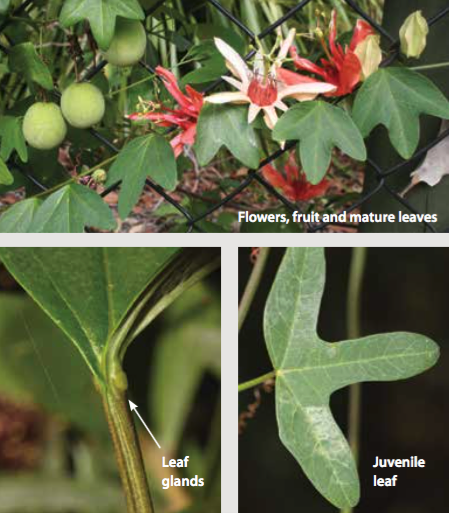
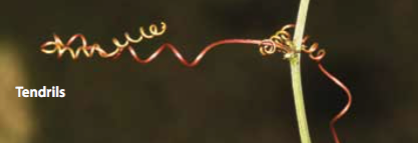
| Location | Eucalypt forests, some rainforest edges, along gullies and creeks. |
| Flowers | Large to 7 cm. Open whitish, then after a few days they turn pale pink, then red before closing. Ovary totally hairless. |
| Leaves | Usually 5 cm, up to 8 cm. Often dull bluish-green, not shiny, and always 3-lobed with each lobe rounded at the tip. Leaf underside is whitish-green. Juvenile leaves are more ‘winged’ than adult leaves. |
| Leaf Glands | Two obvious small glands at base of leaf on either side of leaf stalk. |
| Leaf Stalk | 1-4 cm long. |
| Branchlets | Hairless |
| Fruit | To 3.5 cm long, oblong, green, edible but not palatable. |
Orange Passion Vine (Passiflora aurantia var. pubescens) Native
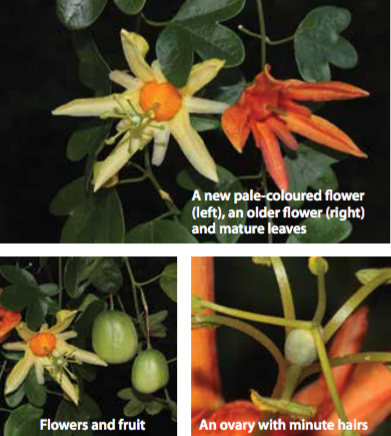
| Location | Our rarest native passion vines, with few records from SEQ in recent times. Found around edges of drier rainforests, and along gullies and creeks. |
| Flowers | Large to 7 cm. Open pale yellow, then after a few days turn orange before closing. Ovary covered in tiny whitish silky hairs. |
| Leaves | Up to 6 cm. Usually glossy green, and always 3-lobed with each lobe rounded at the tip. Leaf underside is a paler green, barely whitish. Juvenile leaves are more ‘winged’ than adult leaves. |
| Leaf Glands | No glands near the base of the leaf, nor on the leaf stalk. |
| Leaf Stalk | 1-4 cm long. |
| Branchlets | Hairless |
| Fruit | To 3.5 cm long, oblong, green, edible but not palatable. |
Yellow Passion Vine (Passiflora herbertiana) Native
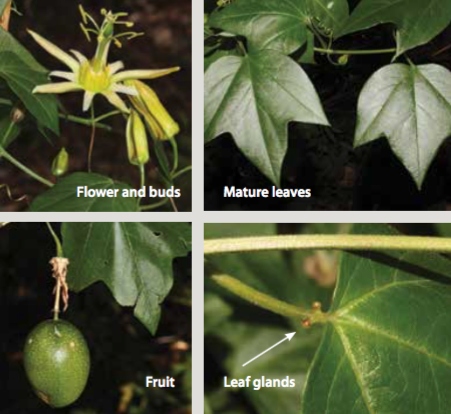
| Location | Eucalypt forests, some rainforest edges, along gullies and creeks. |
| Flowers | Large to 7 cm. Open white and become yellow over the next few days. |
| Leaves | Usually 8 cm, up to 12 cm long. Underside finely hairy. Usually slightly glossy and 3-lobed with each lobe being pointed at the tip. Leaf underside is paler green, never whitish. Sometimes leaves may have 5 lobes or just one lobe. Juvenile leaves are more ‘winged’ than adult leaves. |
| Leaf Glands | Two obvious small glands at base of leaf on either side of leaf stalk. |
| Leaf Stalk | 15.7 cm long. |
| Branchlets | Covered with short fine hairs which are easier to see with a magnifying glass or hand lens. |
| Fruit | To 5 cm long, oblong, green, spotted with pale dots, edible but not tasty. |
Corky Passion Vine (Passiflora suberosa) Weed
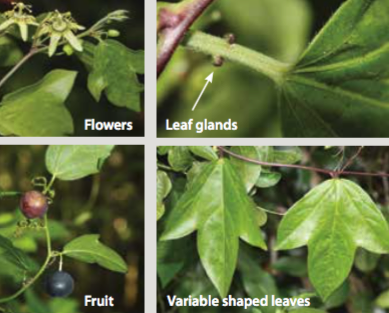
| Location | Eucalypt forests, rainforests and waterways (usually on the edges) and disturbed weedy areas. Rampant, growing over and smothering nearby plants. Suckers from underground roots. Native to South America. |
| Flowers | Small to 2 cm. Greenish yellow with purple centre. |
| Leaves | Up to 10 cm. Variable in shape; unlobed, two-lobed or three-lobed. Lobes usually pointy. Slightly glossy. |
| Leaf Glands | Two raised glands (often reddish) near middle of leaf stalk, or near leaf. |
| Leaf Stalk | 0.5-4 cm long. |
| Branchlets | New growth hairy. Older stems sparsely hairy. Older, lower stems become very corky and pale. |
| Fruit | Small to 1.5 cm, spherical, purplish-black. |
White Passionflower (Passiflora subpeltata) Weed
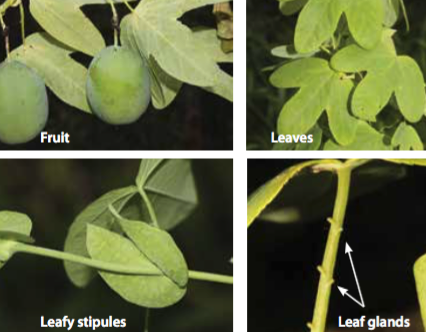
| Location | Eucalypt forests, rainforests and waterways (usually on the edges) and disturbed weedy areas. Rampant, growing over and smothering nearby plants. Suckers from underground roots. Native to Brazil. |
| Flowers | Large to 5 cm. White tinged with green. |
| Leaves | Up to 10 cm. Dull, 3-lobed, with rounded tips. Underside paler green almost whitish. At the base of each leaf stalk are two leafy stipules (like small leaves). |
| Leaf Glands | 1 to 5 scattered along the leaf stalk. |
| Leaf Stalk | 2-6 cm long. |
| Branchlets | Hairless |
| Fruit | To 4 cm, oblong, green, not edible. |
Passionfruit (Passiflora edulis) Weed
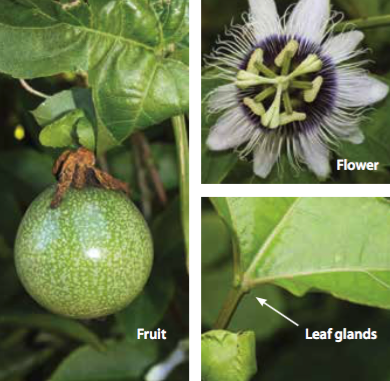
| Location | All environments, including eucalypt forests, roadsides with weeds, rainforests, creeks and gullies. Native to America. |
| Flowers | Large to 6 cm. Startling white and purple; very ornate. |
| Leaves | Up to 15 cm. Glossy 3-lobed with a serrated edge. Underside paler. Sometimes leaves have only one or two lobes, but this is usually only a random leaf or two on a plant, or a seedling. |
| Leaf Glands | Two raised glands on either side of the leaf stalk near the leaf. |
| Leaf Stalk | 2-4 cm long. |
| Branchlets | Hairless |
| Fruit | To 5 cm, oblong, green usually turning purplish or yellowish. Edible and tasty! |
Stinking Passion Vine (Passiflora foetida) Weed
| Location | Eucalypt forests, waterways, roadsides, coastal sand dunes and headlands, and disturbed weedy areas. Native to South America. |
| Flowers | Large to 5 cm. White with sometimes a pink centre. |
| Leaves | Up to 7 cm. 3-lobed, lobes pointy, both surfaces of the leaf hairy, with an unpleasant smell. At the base of the leaf are two small fine feathery stipules. |
| Leaf Glands | None |
| Leaf Stalk | 1-6 cm long, hairy. |
| Branchlets | Hairy |
| Fruit | Slightly oblong or spherical, thin skinned, yellow to orange, surrounded by sticky feather-like bracts. Very sweet to eat...a real treat! |
The Crimson Flowers of P.vitifolia
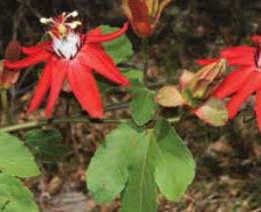
| Crimson Passionflower (Passiflora vitifolia) | Blue Passionflower (Passiflora caerulea) |
| Very uncommon in the wild, often found in bushland next to houses from where it has escaped. Native to the Americas. | Rarely seen in the wild and usually in bushland near houses. Will sucker from underground roots. Native to Brazil. |
| Flowers: Bright red, perfumed flowers with a white centre. | Flowers: White and blue to 8 cm. |
| Leaves: 3-lobed leaves up to 15 cm with serrated edges. Hairy underside. Small saucer-shaped glands at leaf stalk base. | Leaves: 5 to 7-lobed leaves up to 12 cm. Paired leafy stipules (similar to P. subpeltata). Underside pale blue-grey. 2-4 stalked glands on leaf stalk. |
| Fruit: Oblong, hairy, to 5 cm, sour. | Fruit: 6 cm, spherical, yellow or orange. |

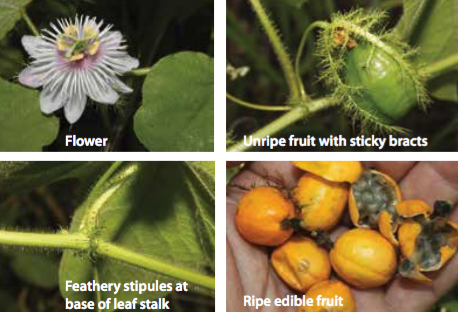
Wow! as a budding bush regenerator half way through my first yeat at TAFE, stumbling upon this article while seeking a reference to my recent introduction to native passiflora by my reluctant long suffering mentor Ian Parer, this short presentation puts it very concisley.
I’d had trouble absorbing the names for subpeltata and suberosa, but knowing the less pestiforous edulis from a life long association since childhood
this article bought all the species in to focus. Long Live Natives! Death to the Invaders!!
Thanks for the article. I am new to SEQ (from WA) and want to know everything about the different plants and animals. I saw a little white passionflower when out walking and wondered if it might be native. It turns out that it is a weed, but it was easy to find out because this article was first up on Google. Fantastic, exactly what I was after. Thank you.
thank you lfwseq for giving me wonderful information
Can anyone tell me about what I think is called Panama Gold? Does it germinate from the seed in it’s dropped fruit and grow true to type? Does it become a problem in bushland?
Hi Gary. Panama Gold is a cultivated hybrid edible passion vine. Edible passion vines can escape into bushland areas but are generally not as invasive as as some of the other weedy passion vines in this article. Given that Panama Gold is a hybrid, it shouldn’t easily propagate from seed.
So useful. Unfortunately I only seem to find corky or edulis on my Bushcare excursions, but it’s very good to be able to make sure I’m not accidentally pulling out a native.
Please advise if the barbed net like fronds in the unripe fruit still remains when the fruit ripens.
This is a wonderful resource for bush care workers. I have never been quite certain that the passiflora vines I see are all the pest varieties – I see that they usually are, except for a few of the domestic fruiting ones we see closer to habitation.
Thanks for posting this.
Hi
A beautiful passiflora species is becoming quite weedy at Ocean Shores – _ P quadrangularis.
Ian Parer
Found this wonderful site first search. Thanks heaps! Thought we might have had a sweet little native passiflora winding its way amongst our native grape and trees….sadly (and typically) it is a feral corky. Tomorrow it will be given the boot from our garden!
Thanks again from FNQ.
I have just found the Orange Passion Vine (Passiflora aurantia var. pubescens) growing in Kangaroo Valley, NSW. The plant is current6in flower with both colours visible. The vine is very healthy. Will be interesting to try the fruit.
Does this mean that on a bushland property it would be best not to grow passionfruit (Passiflora edulis)? We have just purchased a property in an area of designated core koala habitat. In the vegetable garden there is a heap of the passionfruit variety listed above as a weed. I was looking forward to eating the fruit but do not want to grow this variety if the vine has a chance of escaping into the wild bushland areas and becoming a problem.
Hi Liz. Passionfruit (P. edulis) is not a huge weedy problem – unlike Corky Passion Vine or White Passionflower, which are very invasive. If you pick up/eat the fruit, it should be fine to grow and will not escape into the bushland.
P. caerulea fruit is perfectly edible if fully ripe. Less sweet than edulis but can be used with apple in pies, or added to fruit smoothies. Highly nutritious. Picking up the fallen fruit helps to stop seed spread too.